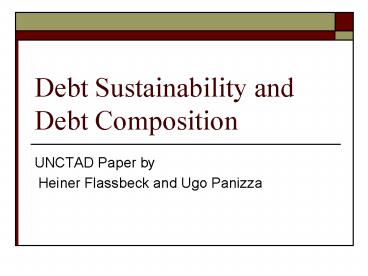Debt Sustainability and Debt Composition - PowerPoint PPT Presentation
Title:
Debt Sustainability and Debt Composition
Description:
Debt Sustainability and Debt Composition UNCTAD Paper by Heiner Flassbeck and Ugo Panizza – PowerPoint PPT presentation
Number of Views:60
Avg rating:3.0/5.0
Title: Debt Sustainability and Debt Composition
1
Debt Sustainability and Debt Composition
- UNCTAD Paper by
- Heiner Flassbeck and Ugo Panizza
2
Introduction
- Problems with DSA exercises
- Often mix the concept of external sustainability
with that of fiscal sustainability - Trend to focus on the level of debt without
considering its composition
3
Outline
- Disentangling Concepts of Sustainability
- External Sustainability and Fiscal Sustainability
- Interactions/Linkages
- Debt Decomposition analysis
- Debt composition
- Proposed composite debt indicator
- Determinants of debt crises
4
Different concepts of sustainability tied to
different types of debt
- External sustainability focuses upon the Transfer
Problem - ability to generate foreign exchange
- Fiscal sustainability focuses upon the Budgetary
Problem - ability to increase or broaden the tax base to
generate revenue
5
External Debt Indicators
- Standard external debt sustainability indicators
- Debt to GDP ratio
- Debt to revenues ratio
- Debt to export ratio
- Weaknesses of these indicators
- These indicators are problematic if import growth
outpaces export growth. - Unless the external debt is issued in domestic
currency, the foreign exchange needed will only
result from a current account surplus. - Not all types of debt carry the same risk
features
6
Fiscal Sustainability Budgetary Problem
- Public debt has an external and domestic
component. - Fiscal sustainability analyses focus on
adjustments to the level and composition of tax
revenue or primary expenditures - Both public debt (domestic vs. external) and
fiscal sustainability lack clear definitions - Formal fiscal sustainability tests are
problematic and are demanding in terms of data. - The tests do not establish any necessary
conditions for long-run sustainability
7
Fiscal Sustainability Indicators
- Common Rule of Thumb ?d (r g) d ps,
where - d is the debt to GDP ratio
- r is the steady state real interest rate
- g is the long run growth rate of real GDP
- ps is the primary surplus to GDP
- Problems
- No well specified definition of sustainability or
of the necessary conditions for LR sustainability - Requires many assumptions on growth, interest
rates, government expenditures and revenues - These variables tend to be endogenous and
correlated with one another
8
Considerations for Developing Countries
- Fiscal sustainability indicator does not account
for the fact that developing countries often - Have a limited capacity to raise taxes
- Have a volatile revenue base
- Are subject to large external shocks (real and
financial) that increase the volatility of GDP
growth - Have high levels of liability dollarization
9
Tradeoffs between External and Fiscal
Sustainability
- Consider a real devaluation
- Positively impacts external sustainability
through increased export competitiveness and
FOREX earnings - Negatively impacts fiscal sustainability if a
large share of public debt is denominated in
foreign currency, results in a jump in the
debt-to-GDP ratio.
10
- These interactions highlight the need for
domestic debt to be included in DSA exercises. - Broad shift towards a greater proportion of
domestic debt in developing countries - Domestic debt has been excluded from DSA
exercises thus far because - Domestic debt has different risk characteristics
- Not appropriate to sum debt of different risk
characteristics together - Data are scarce
11
Important Considerations
- Any attempt of measuring debt sustainability
requires a thorough analysis of the causes of
indebtedness - Analysis purely based on debt levels and on the
forecast of some macroeconomic variables will
lead to nowhere.
12
In a perfect world
- Construct a composite debt indicator
- Decompose external and public debt by
- Maturity and currency characteristics
- Type of lender
- Type of borrower
- Authors propose categorization of external debt
across 12 different levels of risk. - Assigning different weights to different risk
categories to calculate a composite risk measure
13
Back to reality empirical study
- Empirical study examines how debt level and
composition affect the probability of a debt
crisis - Estimate a probit model on an unbalanced panel of
78 developing countries for the 1980-2006 period - Explanatory variables GDP growth international
reserves to GDP, trade openness undervaluation
of the exchange rate growth rate of private
credit fiscal and CA balance inflation
corruption
14
- Total external debt is decomposed into four
components - Total short term external debt
- Long-term private external debt
- Long-term public external debt to private
creditors - Long-term public debt to official creditors
(bilateral and multilateral)
15
Empirical findings
- Examining separate components of total external
debt, authors find evidence that debt composition
matters - Find significant evidence that crises are
positively correlated with long term public debt
owed to private creditors - Find evidence suggesting that the relationship
between default risk and debt with private
creditors is more sensitive to external shocks
than between default risk and debt with official
creditors. - Find evidence that there is less risk associated
with borrowing abroad in their own currency.
16
Conclusions
- Different types of debt may be ranked by risk
- External public debt with private creditors in a
foreign currency (highest risk) - Domestic public debt
- External public debt with official creditors
(lowest risk) - The evidence wrt private debt does not yield
consistent evidence
17
Remaining Obstacles
- Data availability
- International agreement to provide better and
comparable data on debt statistics
18
Thank You































